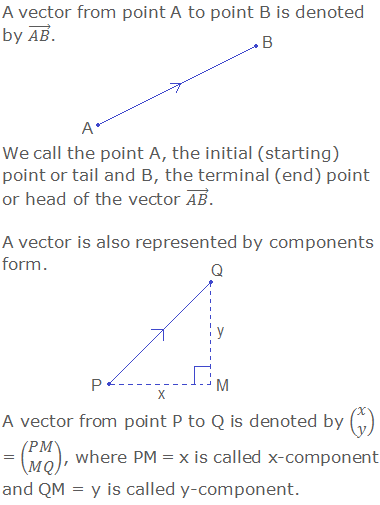
Vectors: Introduction
The quantities which can be measured are
called physical quantities. Some
physical quantities have magnitudes
only but some physical quantities have magnitudes as well as directions.
********************
10 Math Problems officially announces the release of Quick Math Solver and 10 Math Problems, Apps on Google Play Store for students around the world.
********************
********************
Let us study the addition of some
physical quantities. For example, if we have two rectangles of areas 6cm2
and 8cm2, the total areas of these two rectangles is (6 + 8)cm2
i.e. 14cm2.

If two forces 4N and 5N act on a body,
what is the total force acting on the body, 9N or 1N? Its answer is uncertain
unless their directions are known. If two forces have same direction the total
force on the body is 4N + 5N = 9N.

If two forces have opposite direction the
total force on the body is 5N – 4N = 1N.

In the calculation of some physical
quantities, the direction has very
important role.
Scalars and Vectors
Scalar Quantity: A physical
quantity which can be measured with its magnitude only is known as a scalar quantity. For example: mass,
length, area, volume etc.
Vector Quantity: A physical quantity which can be measured with its magnitude as well as direction is known as a vector quantity. For example: velocity, acceleration, force etc.
Vector Notation

Representation of a vector
A vector is generally represented by a
directed line segment. The length of the line segment is chosen according to
some scale to represent the magnitude and the arrow to represent the direction
of the vector.

Directed Line Segments
“If two points of a line are taken, one
as the initial point and another as the terminal point, then it is called a
directed line segment.”

If the length and direction of two directed line
segments are same, they are called equivalent directed line segments or equal
directed line segments. In the figure given below

Position Vector
A point P(x, y) determines its position
with reference to origin O(0, 0). Join OP, draw PN⊥OX, so ON = x and PN = y.

Vectors in Terms of Components
Let P(x1, y1) and Q(x2,
y2) be two points on the plane. From P and Q draw PM⊥OX and QN⊥OX and again draw PR⊥QN.

Worked Out Examples
Example 1: Find the vectors represented by the following line
segments in component form.

Solution: In the above graph,

Example 2: Represent the following vectors by the directed line
segments.

Do you have any questions regarding the vectors and it's components?
You can ask your questions or problems here, in the comment section below.



0 comments: